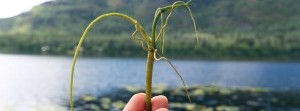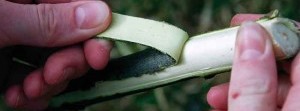
Photo Credit: Brian Smith
Dragonfly nymph: an insect imitation sure to snag still-water trout
There are three common species of dragonfly nymphs found in BC lakes: the “climbers” or darners, which have long and tapered bodies; the “sprawlers,” who are short and squat in shape; and the “burrowers,” or Gomphus nymphs, which are so similar in size and shape to the sprawlers that a fly tier uses the same pattern to imitate them.
As adult insects flying around, the darners are the long blue or olive ones we see and the sprawlers are the smaller red-shouldered variety. All of the species crawl to shore to hatch, usually during hot summer months, and when they are on the move to land they resemble a small army of tanks with a purpose—hatch, find a mate and populate.
When there is no hatch activity, fly fishers use a searching pattern: one that represents an insect and food source always available to the fish, such as scuds, leeches, caddis larvae, damselfly nymphs and the like. As a searching pattern for still-water trout, you will be hard-pressed to find a better insect imitation than a dragonfly nymph fished near the bottom of a lake with a full-sinking line.
I don’t weight my nymphs, preferring instead to use deer hair as an under-body that floats the fly weed-free above the bottom using a number three or four full-sinking line and a short nine-foot leader to get the pattern down. To fish it, make your cast from shoreline to deep water, let the line pull the fly down for a minute or two, and then begin six- to 12-inch strip-and-pause routines.
Brian’s darner dragonfly nymph pattern:
Thread: UTC 140 olive
Hook: Tiemco 200R # 6-10 curved nymph hook
Tail: moose hairs, hook-gap length
Rib: medium copper wire, over abdomen
Underbody: deer hair dyed olive on top of shank, under abdomen
Abdomen: dubbing yellow-olive (I use Ligas 49 mouldy olive for this one)
Wing-case: turkey primary, over thorax and eyes
Rear legs: legs-on-a-stick (knotted pheasant primary fibres), angled down and back
Eyes: v-rib, burned to shape
Front legs: legs-on-a-stick, angled down and forward
Thorax: peacock herls
First, build a base of tying thread on the hook shank so the moose hairs won’t slip. For the tail, attach a bundle of 10 to 12 moose hairs at the shank’s two-thirds point and bind them as far as the hook bend. Take a turn of thread under the hairs at the bend, run your thread back to the two-thirds point, attach the ribbing wire and secure it at the hook bend.
Next, to create an under-body on the rear two-thirds of the hook shank, attach a pencil-width portion of deer hair at the two-thirds point, bind it with thread leaving a small gap at the bend, then fold the hairs back to the two-thirds point and follow it with your tying thread, binding it very tightly to the shank.
To finish the abdomen, return the tying thread back to the hook bend, form a dubbing loop and apply this over the under-body, finishing the abdomen by twisting five to six turns of ribbing material over it and shaping it with a dubbing teaser.
For the wing-case and thorax section, take a one-cm section of turkey primary; fold it once and tie in at the end of the abdomen. Next, attach the rear legs. The leg knots should be at the rear of the abdomen, trimmed to the length of the tail. Attach the V-rib for the eyes a half hook-eye-length from the hook eye, trim it to body width and burn the ends to form the eyes. Attach the front legs behind the eyes and angle them so they sweep down and forward. For the thorax, build a dubbing loop with three to four peacock herls, tie this in at the wing-case and wrap it forward and around the eyes. Finally, bring the wing-case forward over the thorax, legs and eyes, and then tie off the fly pattern.
For a final step, apply five-minute epoxy onto the wing-case and eyes with a dubbing needle.




